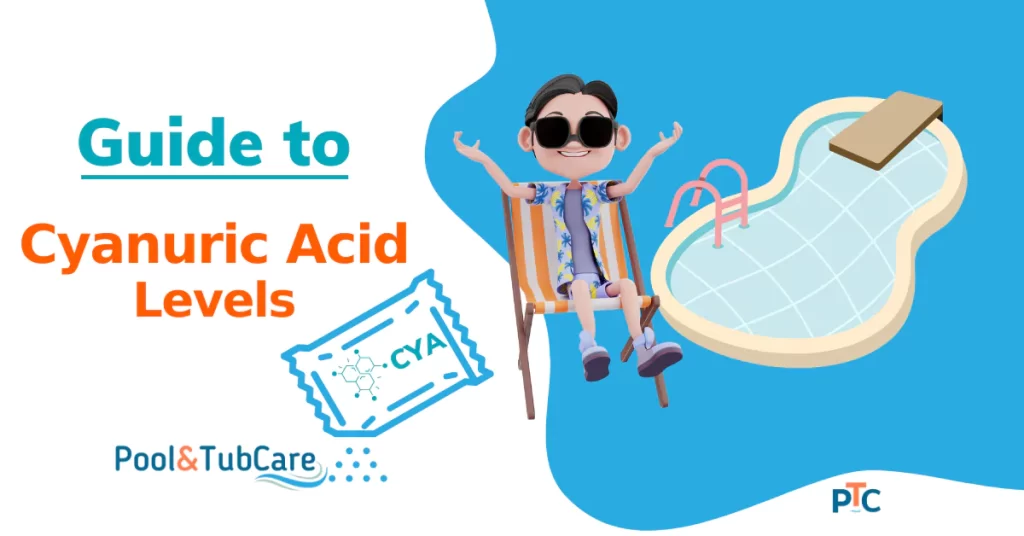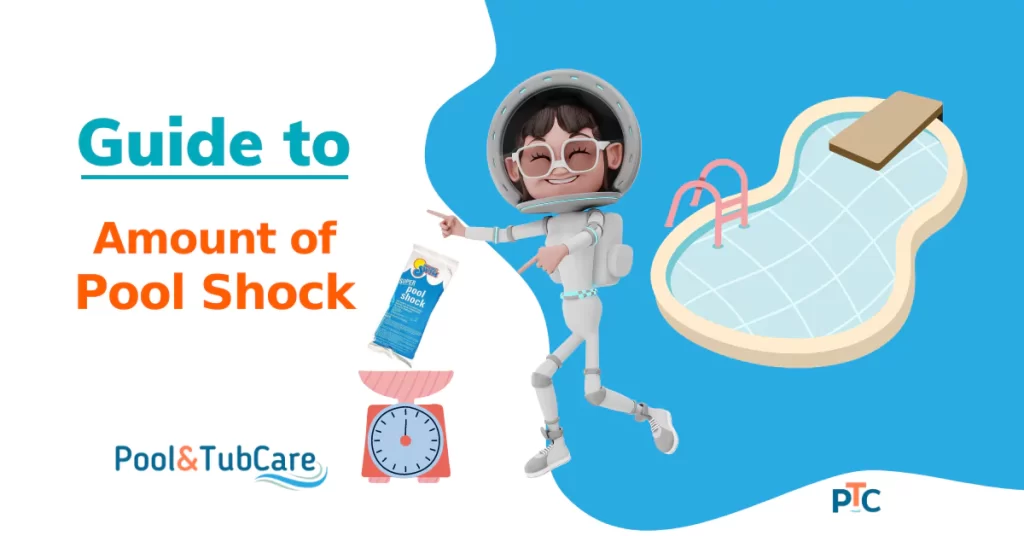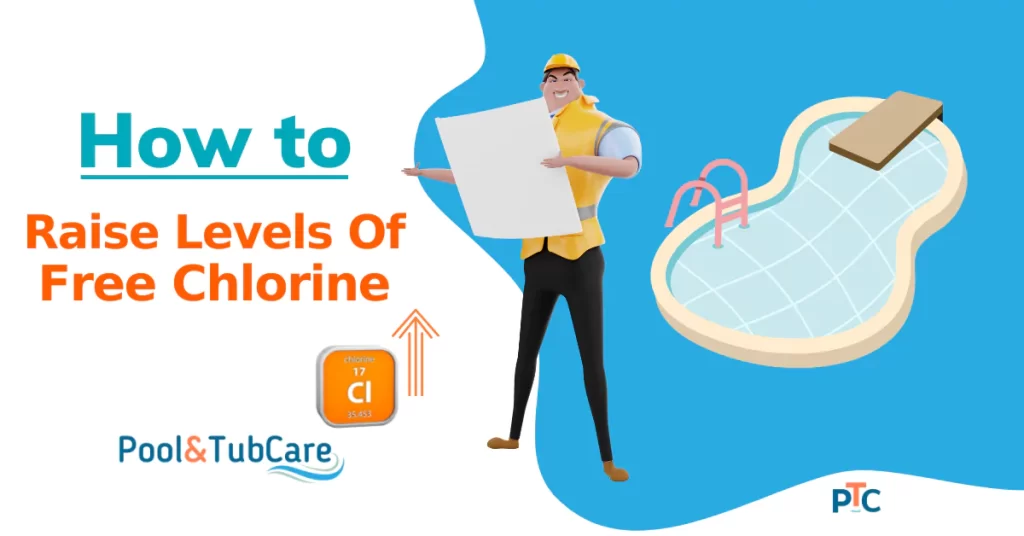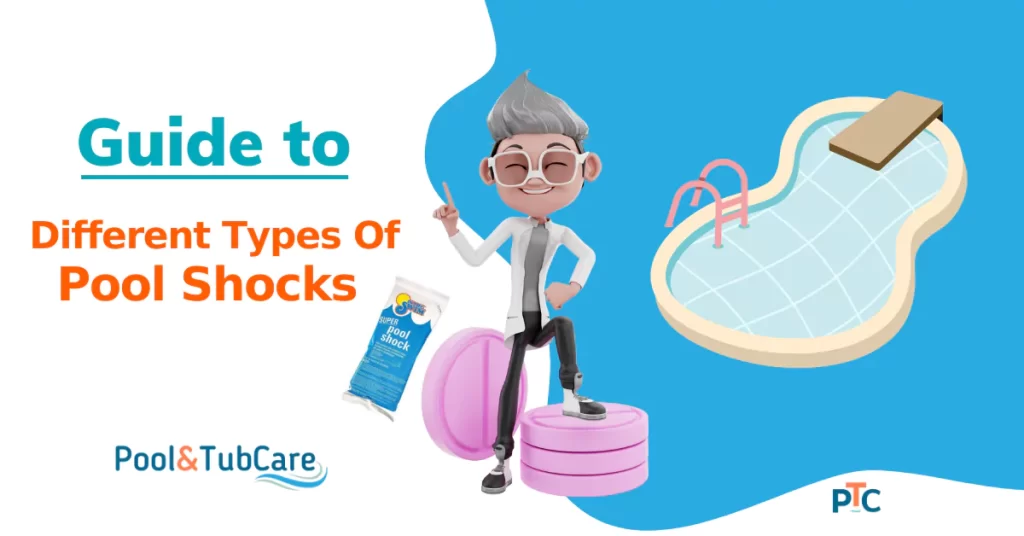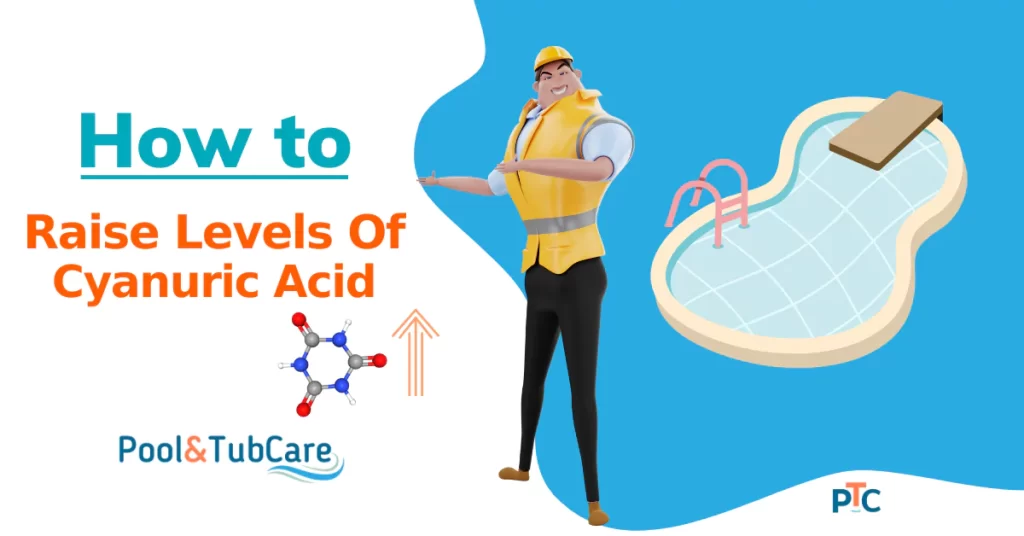Cyanuric acid, or CYA, is a chemical that protects the free chlorine from UV rays of sunlight. It stabilizes the chlorine so that it does not break down immediately upon light exposure. That is why it is also called chlorine stabilizer and “chlorine sunscreen” in the pool care industry.
It is a very important chemical in pool care, especially for outdoor pools.
Without CYA, your pool will require too much chlorine leading to inadequate sanitization and higher costs. Similar to too low CYA, if its levels are too high, then also your chlorine effectiveness will be diminished. Therefore, it is essential to maintain proper CYA levels (30 to 50 ppm) so that your chlorine can keep on working effectively.
Read on to know everything about how CYA works in your pool and how to maintain its levels in your pool water.
What is Cyanuric Acid and How It Works
Cyanuric acid is a weak acid and is generally sold in powder form.
Cyanuric acid works by binding to the free chlorine molecules and stabilizing them. Free chlorine is highly vulnerable to UV rays in sunlight, and without CYA, in about one or two hours, more than half of it gets broken down.
In the presence of CYA, the shelf life of free chlorine increases 4 to 5 times, and the chlorine in the pool can work for longer to kill bacteria and viruses.
If your pool has very low CYA levels, the chlorine will break down within a day of sunlight, and there will be a perpetual need for free chlorine leading to chlorine demand.
In that case, the amount of chlorine will never be enough for proper sanitization leading to other so many problems in your pool. Your pool will become a hotbed for many pathogens and become unsafe for swimming.
When CYA is present with chlorine, it is called stabilized chlorine, and many tablets and granules come in a stabilized form. This is generally a good option for outdoor pools.
When chlorine is not bound or stabilized with CYA, it is called unstabilized chlorine and is generally used for pool shock. This is also useful when your pool already has high levels of cyanuric acid.
What Kind of Pools Need Cyanuric Acid
As cyanuric acid protects chlorine from sunlight, it is essential only for pools that get direct sunlight.
You won’t require cyanuric acid for indoor pools or pools that get significantly less or no sunlight. If you use CYA for such pools, its levels will go up over time as it does not break down on its own.
For this reason, stabilized tablets or chlorine is not recommended for indoor pools. Only use chlorine without CYA in indoor pools.
However, some indoor pools that get UV light exposure will require low doses of CYA.
Saltwater pools are also basically chlorine pools where the final sanitizer is chlorine only, so they also need CYA if they are outdoor.
Optimal Levels of Cyanuric Acid
Maintaining the right amount of cyanuric acid is important as too less, or too much of it, can leave your chlorine ineffective.
The ideal levels of CYA in your pool are 30 to 50 ppm. In recent times experts believe that, in fact, more than the amount of CYA, it is the ratio of CYA to chlorine that is more important.
Free chlorine available in pool water should be around 7.5% of CYA.
Here is the table for reference to maintaining chlorine levels in your pool according to CYA levels.
| CYA Levels | Cl Levels |
|---|---|
| 10 ppm | 0.75 ppm |
| 20 ppm | 1.50 ppm |
| 30 ppm | 2.25 ppm |
| 40 ppm | 3.00 ppm |
| 50 ppm | 3.75 ppm |
What Happens if CYA Levels are Too High
At 30 ppm of CYA, only 3% of chlorine is available to clean our pool. That means out of the recommended 2.25 ppm, 0.07 ppm is available, which is enough, according to experts who believe 0.05 ppm chlorine gets the job done.
The problem arises if the CYA levels go up from 50 ppm. At 60 ppm CYA, less than 2% of chlorine is available for sanitization, and the rest is bound to CYA.
This can lead to a condition called chlorine lock where not enough chlorine is available to do the job, no matter how much your add to the pool.
So, it’s important to keep your CYA levels below 50 ppm, which can reach quite quickly if you are using stabilized chlorine.
Once you reach 50 ppm of CYA, start using unstabilized chlorine to maintain your pool chlorine levels.
High CYA levels are also harmful to your pool surfaces, especially vinyl lining. Though a weak acid, CYA is an acid only and can cause damage to your pool equipment if present in a high amount.
Test CYA levels periodically, and if the levels are not readable, as your strips might not read levels above 100 ppm, use professional services.
Cause of Higher Cyanuric Acid Levels
When you add fresh water to your pool, CYA levels are zero, as naturally, water doesn’t have any CYA.
If you keep adding CYA to your pool regularly, its levels may shoot above 50 ppm. The main reason for too high CYA is using stabilized chlorine to keep up the chlorine levels.
As the chlorine gets depleted every few days, you need to add more frequently to maintain its levels between 1 to 3 ppm. If you use products like dichlor/trichlor or tablets that are stabilized, then with each dosage, you are also increasing CYA levels.
As CYA levels do not go down on their own even if the water evaporates, you will easily cross 50 ppm levels in some time.
Related: Ideal chlorine levels for pool water!
How to Lower Cyanuric Acid Levels
If, after testing, you found that CYA levels are above the recommended range of 30 to 50 ppm, follow these steps to lower Cyanuric Acid levels.
Stop Using Stabilized Chlorine
The first step to dealing with high CYA levels is to stop adding more of it. Before reducing it, you need to stop increasing it.
If you are using chlorine with cyanuric acid, such as tablets, immediately stop using them. Switch to products without CYA, such as liquid chlorine or unstabilized granules.
Refill the Pool with Fresh Water
Then the next step is refilling a part of your pool water with fresh water.
This is your best bet to reduce the CYA levels. Drain some water from your pool with a vacuum or filter waste setting and replace it with fresh water.
You need to replace the amount of water according to the levels of CYA.
If your pool has 25% higher CYA than recommended, like you have 65 ppm of CYA, then you need to replace 25% of your pool water with fresh water.
You might need to backwash your filter as CYA can accumulate in it and enter the pool again.
Circulate Water and Test
Circulate the water in your pool for a few hours so that all water and chemicals mix properly. Then retest the water for CYA levels. If its levels are still high, repeat the above step.
If you have achieved the proper levels, test other chemicals like chlorine and pH reading, as adding more water can imbalance the water chemistry.
Should You Use Cyanuric Acid Reducers
There are few chemical options available to reduce CYA levels. These chemicals can get rid of CYA in your pool without replacing your water.
This can be a good option in areas with water shortages or restrictions.
But they are not recommended as such because almost 50% of users report that they do not work as intended, and on top of that, they may take up to a week to show any results.
They are also costly. You might be among the lucky ones for who they work, but I do not recommend them if you have an option to refill your pool with fresh water.
How to Raise Cyanuric Acid Levels
If you have just filled your pool with fresh water, the levels of CYA will be zero. You need to raise cynuric acid to get to the recommended levels of 30 to 50 ppm.
You just need to add it a few times separately, for example, the first time after filling fresh water. At other times, you will be adding it with other products like stabilized chlorine tablets and granules.
Be sure not to add too much of it at one time. It may shoot over the recommended levels in one go.
Rainwater can also decrease the levels of CYA in your pool as it dilutes the water.
Take cyanuric acid from your local store. Get a bucket and warm water and follow the following steps to increase your CYA levels:
- Wear protective gear like goggles and gloves
- Add warm water to a bucket
- Add the recommended amount of CYA to the water. You need 13 ounces of CYA to increase its levels by ten ppm in 10,000 gallon water
- Mix the CYA in water and add to pool water through the skimmer
- Circulate the water for proper mixing
Maintain a Balance of Cyanuric Acid and Chlorine
At the end of the day, for chlorine to work effectively in your pool, you need to maintain a proper ratio of CYA to chlorine.
Regularly test your water to keep cyanuric acid levels below 50 ppm, as above those levels it will make your chlorine ineffective.
For 3 ppm of free chlorine, keep your CYA levels at 40 ppm. Stop using stabilized chlorine if the levels of CYA go above that.
Keep your pool water chemistry 🧪 maintained, and enjoy swimming in clean water.
FAQs
Here are a few frequently asked questions.
Is it safe to swim in a pool with high cyanuric acid?
High CYA levels can make your chlorine ineffective, leading to a less clean pool. It also causes high alkalinity levels making the water cloudy. So, it is not recommended to use a pool with very high CYA levels.
Does pool shock raise cyanuric acid?
Some shocks like dichlor can contain CYA, but there are shocks available without CYA. We recommend using a shock without CYA. Read the labels carefully before buying.
Using a stabilized shock can raise CYA levels too much, which might cause problems.
Will cyanuric acid lower over time?
No, CYA does not go down on its own even if the water evaporates in the pool. It just gets more concentrated.
Are baking soda and cyanuric acid are same?
No baking soda and CYA are different and work differently. Cyanuric acid stabilizes the chlorine in the pool while baking soda increases the alkalinity. Baking soda can not protect chlorine from sunlight.

